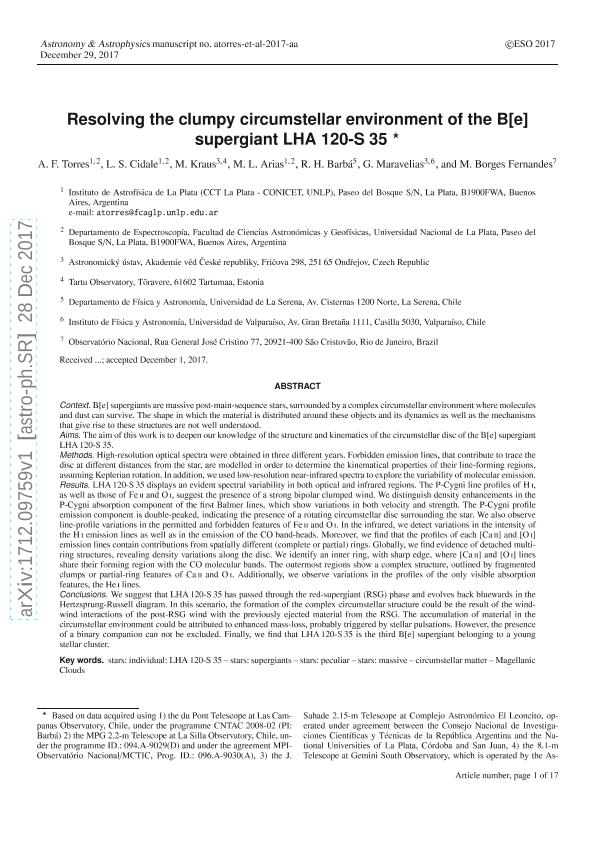Artículo
Resolving the clumpy circumstellar environment of the B[e] supergiant LHA 120-S 35
Torres, Andrea Fabiana ; Cidale, Lydia Sonia
; Cidale, Lydia Sonia ; Kraus, M.; Arias, María Laura
; Kraus, M.; Arias, María Laura ; Barba, Rodolfo Hector
; Barba, Rodolfo Hector ; Maravelias, G.; Borges Fernandes, M.
; Maravelias, G.; Borges Fernandes, M.
 ; Cidale, Lydia Sonia
; Cidale, Lydia Sonia ; Kraus, M.; Arias, María Laura
; Kraus, M.; Arias, María Laura ; Barba, Rodolfo Hector
; Barba, Rodolfo Hector ; Maravelias, G.; Borges Fernandes, M.
; Maravelias, G.; Borges Fernandes, M.
Fecha de publicación:
05/2018
Editorial:
EDP Sciences
Revista:
Astronomy and Astrophysics
ISSN:
0004-6361
Idioma:
Inglés
Tipo de recurso:
Artículo publicado
Clasificación temática:
Resumen
Context. B[e] supergiants are massive post-main-sequence stars, surrounded by a complex circumstellar environment where moleculesand dust can survive. The shape in which the material is distributed around these objects and its dynamics as well as the mechanismsthat give rise to these structures are not well understood.Aims. The aim of this work is to deepen our knowledge of the structure and kinematics of the circumstellar disc of the B[e] supergiantLHA 120-S 35.Methods. High-resolution optical spectra were obtained in three different years. Forbidden emission lines, that contribute to trace thedisc at different distances from the star, are modelled in order to determine the kinematical properties of their line-forming regions,assuming Keplerian rotation. In addition, we used low-resolution near-infrared spectra to explore the variability of molecular emission.Results. LHA 120-S 35 displays an evident spectral variability in both optical and infrared regions. The P-Cygni line profiles of H i,as well as those of Fe ii and O i, suggest the presence of a strong bipolar clumped wind. We distinguish density enhancements in theP-Cygni absorption component of the first Balmer lines, which show variations in both velocity and strength. The P-Cygni profileemission component is double-peaked, indicating the presence of a rotating circumstellar disc surrounding the star. We also observeline-profile variations in the permitted and forbidden features of Fe ii and O i. In the infrared, we detect variations in the intensity ofthe H i emission lines as well as in the emission of the CO band-heads. Moreover, we find that the profiles of each [Ca ii] and [O i]emission lines contain contributions from spatially different (complete or partial) rings. Globally, we find evidence of detached multi-ring structures, revealing density variations along the disc. We identify an inner ring, with sharp edge, where [Ca ii] and [O i] linesshare their forming region with the CO molecular bands. The outermost regions show a complex structure, outlined by fragmentedclumps or partial-ring features of Ca ii and O i. Additionally, we observe variations in the profiles of the only visible absorptionfeatures, the He i lines.Conclusions. We suggest that LHA 120-S 35 has passed through the red-supergiant (RSG) phase and evolves back bluewards in theHertzsprung-Russell diagram. In this scenario, the formation of the complex circumstellar structure could be the result of the wind-wind interactions of the post-RSG wind with the previously ejected material from the RSG. The accumulation of material in thecircumstellar environment could be attributed to enhanced mass-loss, probably triggered by stellar pulsations. However, the presenceof a binary companion can not be excluded. Finally, we find that LHA 120-S 35 is the third B[e] supergiant belonging to a youngstellar cluster.
Archivos asociados
Licencia
Identificadores
Colecciones
Articulos(IALP)
Articulos de INST.DE ASTROFISICA LA PLATA
Articulos de INST.DE ASTROFISICA LA PLATA
Citación
Torres, Andrea Fabiana; Cidale, Lydia Sonia; Kraus, M.; Arias, María Laura; Barba, Rodolfo Hector; et al.; Resolving the clumpy circumstellar environment of the B[e] supergiant LHA 120-S 35; EDP Sciences; Astronomy and Astrophysics; 612; 5-2018; 1-17
Compartir
Altmétricas



